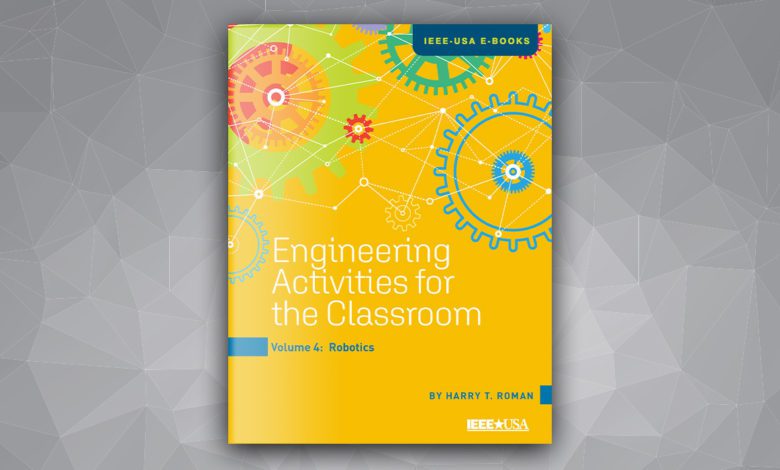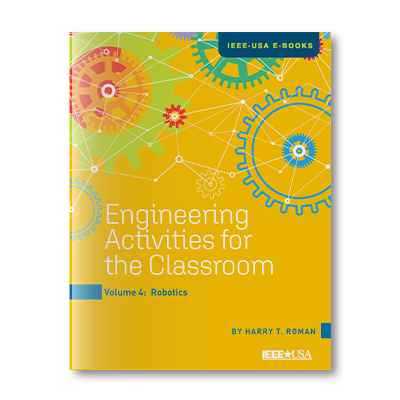
I asked a recent graduate of a mechanical engineering program if high school had adequately prepared her for a vigorous engineering program. She responded that her high school math and science courses did prepare her, but in her college class on robotics, she was way behind. The majority of her classmates had previously been exposed to robotics in the classroom, or through robotics clubs. She had not.
In his new IEEE-USE e-book, Engineering Activities for the Classroom Volume 4: Robotics, veteran educator Harry T. Roman gives teachers a way to expose their students of almost any age to robotics. The book provides practical activities to introduce students to robotics, and it gives them a better understanding of careers in the field. In addition, Roman offers an in-class design challenge to excite and engage students.
This e-book is Roman’s fourth in a series of engineering activities for the classroom. Previous books in the series dealt with Telecommunications and Computers, Energy in Our World, and Engineering. Volume 4: Robotics, as well as the three previous books, are all available at the IEEE-USA Shop at https://ieeeusa.org/shop/ — free for members and $2.99 for non-members.
Roman, who has been inducted into the New Jersey Inventors Hall of Fame for his application of mobile robots in hazardous work environments, has worked extensively in classrooms, pre- and post-retirement. He imparts valuable and helpful ideas for both the novice and experienced teacher.
He starts with a key list of robotics terms to have students look up and research, such as teleoperation, force reflection, end effector and mechatronics. Then, the author provides exercises on the history of robots, such as making a timeline of robotic development, identifying movies or books that feature robots, identifying how robots are used today (such as assistants for senior citizens, or in military applications). Further, Roman suggests students formulate ideas on how the advancement of robotics might assist in developing advanced prosthetic systems for humans.
Roman points out that mobile robots (sometimes referred to as “service robots”) are used in such diverse places as museums and hospitals — and increasingly in environmentally dangerous places. He gives additional questions for teachers to ponder with their students, including how service robots are used; how humans communicate with mobile robots; and should we consider drones and self-guided cars to be robots?
The author suggests teachers help their students explore a future in robotics-related jobs by inviting a robot engineer to come and talk at the school; taking a class to visit a local university’s robotics lab; or researching various robotics jobs, then determining how much they pay, and how much demand there is for that type of work.
Roman worked with a team that developed robotics in the energy industry, including co-inventing one now used all over the world to inspect large fuel oil storage tanks, and another one used in nuclear power plants. Drawing on his extensive experience, he offers up 14 specific steps to take a student (or engineer) from the conceptualizing of a robotic application to implementation of full-scale use.
The author ends his book with a two-hour robot challenge he has used in numerous classes from high school down to as young as the 3rd grade. He notes that “the creativity I have seen displayed in these exercises is nothing short of incredible” and that “it never fails to get folks fired up.”
As with all his books, Roman encourages applying the subject at hand to one of the environments students know best: their schools. He divides the students into teams of five. Then, Roman gives all the teams a robot design challenge — such as to design a robot that would clean the school after hours, fight a fire in a school building, assist a physically challenged classmate — or even a serve as a robot teacher.
The team first assigns a role to each member — a marketer (charged with making sure the robot being designed can accomplish the task given); an economist (to determine and monitor project costs); an engineer (to look at the technical details of the robot design); an activist (who evaluates the legal, safety and environmental impacts of a design); and a team captain (who coordinates communication among members and gives the oral presentation at the end of the exercise). Roman suggests each team have five to 10 minutes to report at the end; and for older students, to incorporate a written team report.
Roman holds 12 U.S. Patents and has received numerous engineering, invention and teaching awards. IEEE has honored Roman with a Meritorious Achievement Award for developing continuing education products for IEEE members. He currently teaches a graduate course at Montclair State University about applying STEM techniques in the classroom. He is also a docent/special lecturer at the Thomas Edison National Historical Park, in West Orange, New Jersey.
Paul Lief Rosengren is the coauthor of In the Time of Covid: One Hospital’s Struggles and Triumphs. He worked for more than three decades in corporate communications at NBC, PSE&G, BD and in state government. He has a Master’s in Public Policy from The Kennedy School of Government, Harvard; and an undergraduate degree in political science from Dickinson College.







